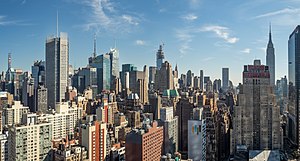
Back اقتصاد مدينة نيويورك Arabic Economía de Nueva York Spanish New Yorgi majandus Estonian اقتصاد نیویورک Persian Նյու Յորքի տնտեսություն Armenian Ekonomi Kota New York ID ニューヨーク市の経済 Japanese 뉴욕의 경제 Korean Economia da cidade de Nova Iorque Portuguese Экономика Нью-Йорка Russian


| This article is part of a series on the |
| Economy of the United States |
|---|
 |
The economy of New York City encompasses the largest municipal and regional economy in the United States. In 2022, the New York metropolitan area generated a gross metropolitan product (GMP) of US$1.4trillion,[5] with a population of 23.6 million people. Anchored by Wall Street in Lower Manhattan, New York City has been characterized as the world's premier financial center.[6][7][8][9] The city is home to the New York Stock Exchange (NYSE, on Wall Street) and Nasdaq (headquartered in Times Square), the world's two largest stock exchanges by both market capitalization and trading activity.
New York City, with its center in Manhattan, is the world's leading center of banking, finance,[9] and communication. Many of the world's largest corporations are headquartered in Manhattan. The borough contained over 500 million square feet (46.5 million m2) of office space in 2015,[10] making it the largest office market in the United States.[11] Midtown Manhattan, with nearly 400 million square feet (37.2 million m2) that same year,[10] is the largest central business district in the world.[12] New York City is distinctive for its high concentrations of advanced service sector firms in the law, accountancy, banking, and management consultancy fields. It is the top global center for the advertising industry, which is metonymously called "Madison Avenue". Silicon Alley, metonymous for New York's broad-spectrum high technology sphere, continues to expand.
Finance, health care and life sciences,[13] high technology and biotechnology, real estate, and insurance all form the basis of New York City's economy. The city is also the nation's most important center for mass media, journalism, and publishing. Also, it is the country's preeminent arts center. Creative industries such as digital media, advertising, fashion, design, and architecture account for a growing share of employment. New York City possesses strong competitive advantages in these industries.[14] Despite declining, manufacturing remains consequential. The Port of New York and New Jersey is a major economic engine, handling a maritime cargo volume in the ten months through October 2022 of over 8.2 million TEUs, benefitting post-Panamax from the expansion of the Panama Canal, and accelerating ahead of California seaports in monthly cargo volumes.[15][16]
- ^ Iman Ghosh (September 24, 2020). "This 3D map shows the U.S. cities with the highest economic output". World Economic Forum. Retrieved March 5, 2023.
The New York metro area dwarfs all other cities for economic output by a large margin.
- ^ "The Global Financial Centres Index 36". Long Finance. September 24, 2024. Retrieved September 28, 2024.
- ^ Jones, Huw. "New York widens lead over London in top finance centres index". Reuters. Retrieved September 28, 2024.
- ^ Laura Bratton (September 28, 2023). "Sorry, London — New York Is Still the Financial Capital of the World". The Messenger. Archived from the original on October 11, 2023. Retrieved September 28, 2024.
The GDP of the New York City metropolitan area is larger than the country of South Korea...New York City was ranked as the most competitive city in the financial industry for the fifth straight year.
- ^ "Real GDP New York U.S. 2023".
- ^ "Top 8 Cities by GDP: China vs. The U.S." Business Insider, Inc. July 31, 2011. Retrieved July 29, 2014.
- ^ "UBS may move US investment bank to NYC". e-Eighteen.com Ltd. June 10, 2011. Retrieved July 29, 2014.
- ^ Richard Florida (May 8, 2012). "What Is the World's Most Economically Powerful City?". The Atlantic Monthly Group. Retrieved July 29, 2014.
- ^ a b "The Global Financial Centres Index 32". Long Finance. September 22, 2022. Retrieved September 22, 2022.
- ^ a b Andrew Nelson. "Top CBDs See Solid Growth in 2nd Quarter, US - Canada Performance Diverges" (PDF). Colliers International. Retrieved April 10, 2016.
- ^ "Understanding The Manhattan Office Space Market". Officespaceseeker.com. Retrieved April 10, 2016.
- ^ "Marketbeat United States CBD Office Report 2Q11" (PDF). Cushman & Wakefield, Inc. Archived from the original (PDF) on May 8, 2013. Retrieved April 10, 2016.
- ^ "Governor Hochul, Mayor Adams Announce Plan for SPARC Kips Bay, First-of-Its-Kind Job and Education Hub for Health and Life Sciences Innovation". State of New York. October 13, 2022. Retrieved October 13, 2022.
- ^ Currid, Elizabeth (2006). "New York as a Global Creative Hub: A Competitive Analysis of Four Theories on World Cities". Economic Development Quarterly. 20 (4): 330–350. doi:10.1177/0891242406292708. S2CID 154428747.
- ^ "Port of New York and New Jersey Monthly Cargo Volumes". Port Authority of New York and New Jersey. Retrieved December 10, 2022.
- ^ Vanessa Yurkevich (December 9, 2022). "The busiest port in America is no longer on the West Coast". CNN. Retrieved December 10, 2022.